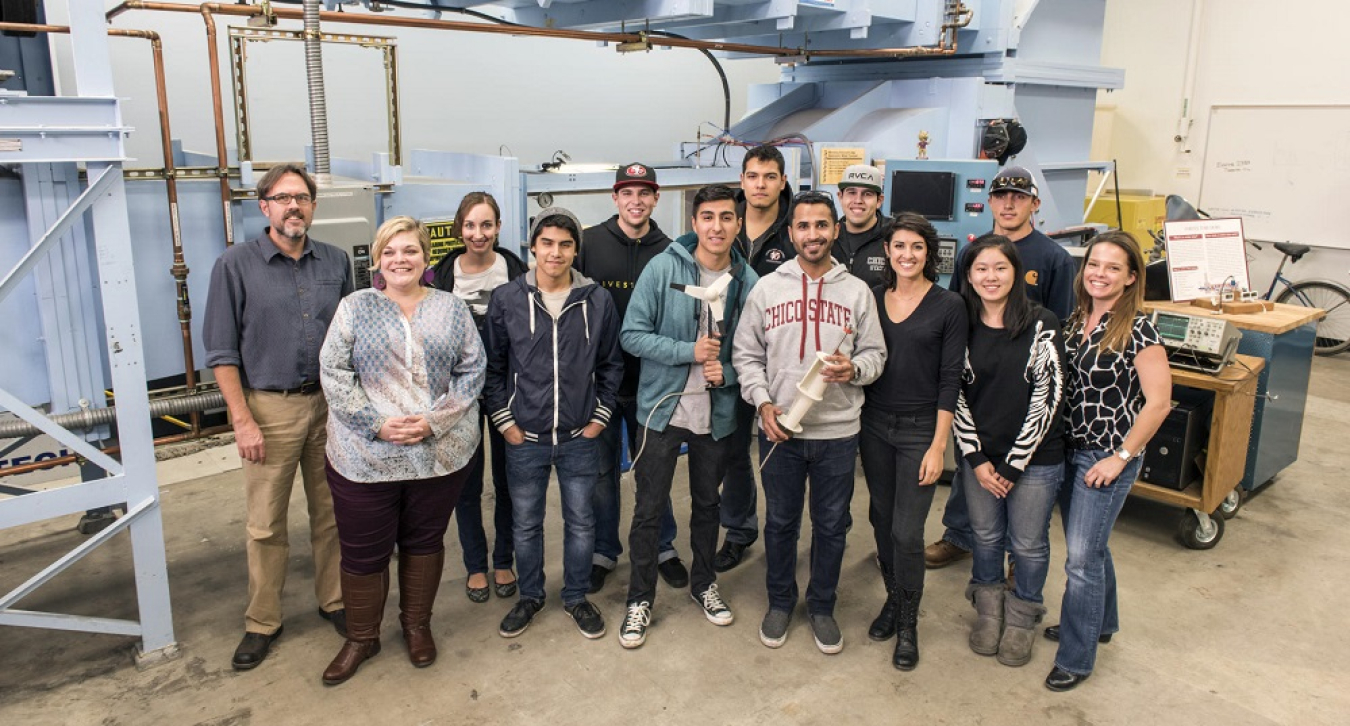
Team roster: Aditya Joshi , Computer Science; Angelina Teal Jonson, Mechanical Engineering; Aubrey Connors, Business Administration, Option: Entrepreneurship; Colleen Robb, Co-PI, Entrepreneurship, College of Business; Corey Starbird, Electrical Engineering; Darrell Sinclair, Mechanical Engineering; David Alexander, PI, Mechanical Engineering; Eric Myers, Business Administration, Option: Entrepreneurship; Henry Sanchez, Mechanical and Mechatronic Engineering; Jonathan Torres, Business Administration, Option: Entrepreneurship; Jorge Alvarado, Electrical and Mechatronic Engineering; Karola Grant, Business Administration, Option: Entrepreneurship; Riki Romero, Business Administration, Option: Entrepreneurship; Ryan McDonald, Marketing; Sergio Llamas, Mechatronic Engineering; Yahya Al Maqboul, Mechatronic Engineering; Yuanyuan Ju, Mechanical Engineering

TEAM NAME:
WHY WIND?
Students at California State University, Chico are interested in learning more about different types of renewable energy because they believe that renewable energy is going to be the future, and they want to make contributions to advance wind energy as a clean source of power. The experience the students will gain by working with other students from other disciplines will be extremely valuable both personally and professionally.
PROJECT DESCRIPTION:
The California State University, Chico, WindCats are developing a small-to-medium sized, three-blade, horizontal axis wind turbine to provide power to an electrical load. The turbine design and control system are being developed for their intended market applications with reliability, sustained performance, and easily sourced components as the main design considerations. They were identified through detailed market research and customer interviews. The application is designed to provide power to areas that currently lack sufficient electrical grid infrastructure. The team has working prototypes and is undergoing preliminary testing while market research continues to optimize deployment and business strategies.
GAME PLAN:
The WindCats created a team contract that its members have all given input to and signed. This contract details team communication, processes for conflict resolution, and expectations for assignments. The entire team meets once a week to make decisions. These meetings usually contain information that affects everyone, and leads for each task meet with their respective students to work on other areas of the competition.
The WindCats are using their course curriculum to focus on the business plan, market analysis, and technical design. Business students are enrolled in a social entrepreneurship class that allows them to focus on the market application. During the spring, many of these students will be enrolled in a business plan and financing course to focus on developing the business plan for the competition. The engineers are using the technical design portion of the competition as their year-long senior capstone project.
TEAM STRENGTH:
The technical design has been the team’s strongest area thus far. Their engineers have worked on many projects prior to their senior years in both curricular and in extracurricular activities. One team engineer has and is currently building a quadcopter; others have experience in industry. Regarding hands-on experience in engineering design, the team is prepared to create a high-quality prototype.
TEAM HURDLES:
Business Plan
The main challenge the team faces is figuring out what its market application will be. Team members have discussed a variety of topics and say that the toughest part has been figuring out why anyone else isn’t doing this. In general, they found the answer to be that their target market wouldn’t likely be interested because of current alternatives, or just that it’s not financially reasonable.
Technical Design
The team found many different types of wind turbines, but justifying their choice of a type for a market application was very challenging. Other challenges of design have been how to select an appropriate blade or a generator. With so many different options, figuring out needed criteria and whether their choice will be sufficient is a true test of what they have learned in the classroom.
Deployment Strategy
This entire portion of the competition has been challenging simply because the team members have never done anything like this. For example, project life cycle considers many different aspects, such as how long an area can’t be used for operations. This could potentially cause a loss of income. If a project life cycle causes too much loss of income for a customer, the idea is thrown out the window.
Turbine Performance Testing
The team has been fortunate enough to have a wind tunnel on campus and also an engineering course in which they learn the basics of wind turbines. However, the challenge they encountered with initial testing of the university’s turbine is modifying it. They needed to place a shroud on it without damaging or permanently altering the turbine. That resulted in an awkward solution with duct tape. It worked.
Bonus Challenge
The team visualizes a display using a creative LED design at the very least, but the power consumption of whatever they design may affect their load system. Once their prototype is built and testing begins with the turbine, they will be able to determine what amount of power can be used toward the load display.
TEAM TAKEAWAY:
The most important thing the team has been taking away from the competition is the experience of working with and building a product alongside team members who all think completely differently. The team believes that this interdisciplinary experience will be a great résumé builder and will also present opportunities in the renewable energy industry.

